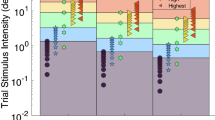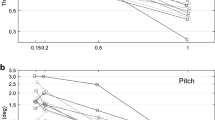Abstract
Vestibular reflexes are critically important for stabilizing gaze and maintaining posture, but comparatively little is known about conscious perceptions of vestibular stimuli and how they may relate to balance function. We used psychophysical methods to determine the ability of normal subjects and a vestibular-deficient subject to discriminate among velocities of earth-vertical sinusoidal rotations. Discrimination thresholds in normal subjects rose from 2.26 deg/s at a peak velocity of 20 deg/s up to 5.16 deg/s at 150 deg/s. The relationship between threshold and peak angular velocity was well described by the power law function ΔI = 0.88I 0.37, where I is the magnitude of the stimulus and ΔI is the discrimination threshold. The subject with bilateral vestibular hypofunction had thresholds more than an order of magnitude worse than normals. The performance of normal subjects is much better than that predicted by Weber’s Law, which states that discrimination thresholds increase proportionally with stimulus magnitude (i.e., ΔI/I = C, where C is the “Weber fraction”). This represents a remarkable exception to other sensory systems and may reflect the vestibular system’s ability to stabilize gaze and maintain posture even at high stimulus intensities. Quantifying this relationship may help elucidate the role of higher-level processes in maintaining balance and provide information to diagnose and guide therapy of patients with central causes for imbalance.




Similar content being viewed by others
References
Au Yong N, Paige GD, Seidman SH (2007) Multiple sensory cues underlying the perception of translation and path. J Neurophysiol 97:1100–1113
Baird JC (1997) Sensation and judgment. Lawrence Erlbaum Associates, Mahwah, NJ
Baird RA, Desmadryl G, Fernandez C, Goldberg JM (1988) The vestibular nerve of the chinchilla. II. Relation between afferent response properties and peripheral innervation patterns in the semicircular canals. J Neurophysiol 60:182–203
Benson AJ (1982) The vestibular sensory system. In: Barlow HB, Mollon JD (eds) The senses. Cambridge University Press, Cambridge, pp 333–368
Benson AJ, Brown SF (1992) Perception of liminal and supraliminal whole-body angular motion. In: Berthoz A, Graf W, Vidal PP (eds) The head-neck sensory motor system. Oxford University Press, New York, pp 483–487
Benson AJ, Spencer MB, Stott JR (1986) Thresholds for the detection of the direction of whole-body, linear movement in the horizontal plane. Aviat Space Environ Med 57:1088–1096
Benson AJ, Hutt EC, Brown SF (1989) Thresholds for the perception of whole body angular movement about a vertical axis. Aviat Space Environ Med 60:205–213
Brannon EM, Libertus ME, Meck WH, Woldorff MG (2008) Electrophysiological measures of time processing in infant and adult brains: Weber’s Law holds. J Cogn Neurosci 20:193–203
Brown JH (1966) Magnitude estimation of angular velocity during passive rotation. J Exp Psychol 72:169–172
Clement G, Tilikete C, Courjon JH (2008) Retention of habituation of vestibulo-ocular reflex and sensation of rotation in humans. Exp Brain Res 190:307–315
Dai M, Klein A, Cohen B, Raphan T (1999) Model-based study of the human cupular time constant. J Vestib Res 9:293–301
Day BL, Fitzpatrick RC (2005) The vestibular system. Curr Biol 15:R583–R586
Dehaene S (2003) The neural basis of the Weber-Fechner law: a logarithmic mental number line. Trends Cogn Sci 7:145–147
Della Santina CC, Potyagaylo V, Migliaccio AA, Minor LB, Carey JP (2005) Orientation of human semicircular canals measured by three-dimensional multiplanar CT reconstruction. J Assoc Res Otolaryngol 6:1–16
Fechner G (1860) Elemente der Psychophysik. Breitkopf & Härtel, Leipzig
Fernandez C, Goldberg JM (1971) Physiology of peripheral neurons innervating semicircular canals of the squirrel monkey II. Response to sinusoidal stimulation and dynamics of peripheral vestibular system. J Neurophys 34:661–675
Francisco E, Tannan V, Zhang Z, Holden J, Tommerdahl M (2008) Vibrotactile amplitude discrimination capacity parallels magnitude changes in somatosensory cortex and follows Weber’s Law. Exp Brain Res 191:49–56
Friedmann G (1970) The judgement of the visual vertical and horizontal with peripheral and central vestibular lesions. Brain 93:313–328
Gescheider GA, Bolanowski SJ Jr, Verrillo RT, Arpajian DJ, Ryan TF (1990) Vibrotactile intensity discrimination measured by three methods. J Acoust Soc Am 87:330–338
Gianna C, Heimbrand S, Gresty M (1996) Thresholds for detection of motion direction during passive lateral whole-body acceleration in normal subjects and patients with bilateral loss of labyrinthine function. Brain Res Bull 40:443–449
Glasauer S, Amorim MA, Viaud-Delmon I, Berthoz A (2002) Differential effects of labyrinthine dysfunction on distance and direction during blindfolded walking of a triangular path. Exp Brain Res 145:489–497
Golding JF, Benson AJ (1993) Perceptual scaling of whole-body low frequency linear oscillatory motion. Aviat Space Environ Med 64:636–640
Grabherr L, Nicoucar K, Mast FW, Merfeld DM (2008) Vestibular thresholds for yaw rotation about an earth-vertical axis as a function of frequency. Exp Brain Res 186:677–681
Green DM, Swets JA (1966) Signal detection theory and psychophysics. Wiley, NY
Grossman GE, Leigh RJ, Abel LA, Lanska DJ, Thurston SE (1988) Frequency and velocity of rotational head perturbations during locomotion. Exp Brain Res 70:470–476
Guedry FEJ (1974) Psychophysics of vestibular sensation. In: Kornhuber HH (ed) Handbook of sensory physiology vestibular system. Springer, New York, pp 3–154
Guilford JP (1932) A generalized psychophysical law. Psychol Rev 39:73–85
Hullar T (2008) Neurometric and psychometric thresholds of the semicircular canals. Soc Neurosci Abs 168:8
Hullar T, Zee D, Minor L (2005a) Evaluation of the patient with dizziness. In: Cummings C (ed) Otolaryngology—head and neck surgery. Elsevier, Philadelphia
Hullar TE, Della Santina CC, Hirvonen TP, Lasker DM, Carey JP, Minor LB (2005b) Responses of irregularly discharging chinchilla semicircular canal vestibular-nerve afferents during high-frequency head rotations. J Neurophysiol 93:2777–2786
Kiesow E (1926) Über die Vergleichung linearer Strecken und ihre Beziehung zum Weberschen Gesetze. Arch Gesamte Psychol 56:421–462
Kingma H (2005) Thresholds for perception of direction of linear acceleration as a possible evaluation of the otolith function. BMC Ear Nose Throat Disord 5:5
Laming D (1986) Weber’s law. In: Sensory analysis. Academic Press, London, pp 1–17
Leek MR (2001) Adaptive procedures in psychophysical research. Percept Psychophys 63:1279–1292
Leek MR, Dubno JR, He N, Ahlstrom JB (2000) Experience with a yes–no single-interval maximum-likelihood procedure. J Acoust Soc Am 107:2674–2684
Leigh R, Zee D (2006) The neurology of eye movements. Oxford University Press, New York
MacDougall HG, Moore ST (2005) Marching to the beat of the same drummer: the spontaneous tempo of human locomotion. J Appl Physiol 99:1164–1173
Mach E (1875) Grundlinien der Lehre von den Bewegungsempfindungen. Engelman, Leipzig
Macmillan NA, Creelman CD (2005) Detection theory: a user’s guide. Lawrence Erlbaum Associates, Mahwah
McGill WJ, Goldberg JP (1968) Pure-tone intensity discrimination and energy detection. J Acoust Soc Am 44:576–581
Merfeld DM, Park S, Gianna-Poulin C, Black FO, Wood S (2005a) Vestibular perception and action employ qualitatively different mechanisms. I. Frequency response of VOR and perceptual responses during Translation and Tilt. J Neurophysiol 94:186–198
Merfeld DM, Park S, Gianna-Poulin C, Black FO, Wood S (2005b) Vestibular perception and action employ qualitatively different mechanisms. II. VOR and perceptual responses during combined Tilt & Translation. J Neurophysiol 94:199–205
Mittelstaedt H (1998) Origin and processing of postural information. Neurosci Biobeh Rev 22:473–478
Okada T, Grunfeld E, Shallo-Hoffmann J, Bronstein AM (1999) Vestibular perception of angular velocity in normal subjects and in patients with congenital nystagmus. Brain 122:1293–1303
Pulaski PD, Zee DS, Robinson DA (1981) The behavior of the vestibulo-ocular reflex at high velocities of head rotation. Brain Res 222:159–165
Raphan T, Matsuo V, Cohen B (1979) Velocity storage in the vestibulo-ocular reflex arc (VOR). Exp Brain Res 35:229–248
Sadeghi SG, Chacron MJ, Taylor MC, Cullen KE (2007) Neural variability, detection thresholds, and information transmission in the vestibular system. J Neurosci 27:771–781
Seemungal BM, Gunaratne IA, Fleming IO, Gresty MA, Bronstein AM (2004) Perceptual and nystagmic thresholds of vestibular function in yaw. J Vestib Res 14:461–466
Seidman SH (2008) Translational motion perception and vestiboocular responses in the absence of non-inertial cues. Exp Brain Res 184:13–29
Sinha N, Zaher N, Shaikh AG, Lasker AG, Zee DS, Tarnutzer AA (2008) Perception of self motion during and after passive rotation of the body around an earth-vertical axis. Prog Brain Res 171:277–281
Stevens SS (1961) To honor Fechner and repeal his law: a power function, not a log function, describes the operating characteristic of a sensory system. Science 133:80–86
Walsh EG (1961) Role of the vestibular apparatus in the perception of motion on a parallel swing. J Physiol (Lond) 155:506–513
Weber KP, Aw ST, Todd MJ, McGarvie LA, Curthoys IS, Halmagyi GM (2008) Head impulse test in unilateral vestibular loss: vestibulo-ocular reflex and catch-up saccades. Neurology 70:454–463
Wichmann FA, Hill NJ (2001) The psychometric function: I. Fitting, sampling, and goodness of fit. Percept Psychophys 63:1293–1313
Wilson VJ, Jones GM (1979) Mammalian vestibular physiology. Plenum, London
Wood SJ, Reschke MF, Sarmiento LA, Clement G (2007) Tilt and translation motion perception during off-vertical axis rotation. Exp Brain Res 182:365–377
Zanker JM (1995) Does motion perception follow Weber’s law? Perception 24:363–372
Acknowledgments
We would like to thank Dora Angelaki, Larry Snyder, and Nancy Tye-Murray for their thoughtful contributions to this work. Support provided by NIH/NIDCD grant K08 DC 006869 (TEH) and by the Howard Hughes Medical Institute (RMM and TEH).
Author information
Authors and Affiliations
Corresponding author
Rights and permissions
About this article
Cite this article
Mallery, R.M., Olomu, O.U., Uchanski, R.M. et al. Human discrimination of rotational velocities. Exp Brain Res 204, 11–20 (2010). https://doi.org/10.1007/s00221-010-2288-1
Received:
Accepted:
Published:
Issue Date:
DOI: https://doi.org/10.1007/s00221-010-2288-1




